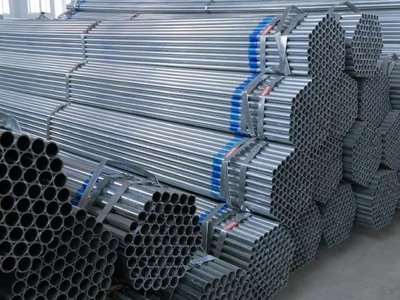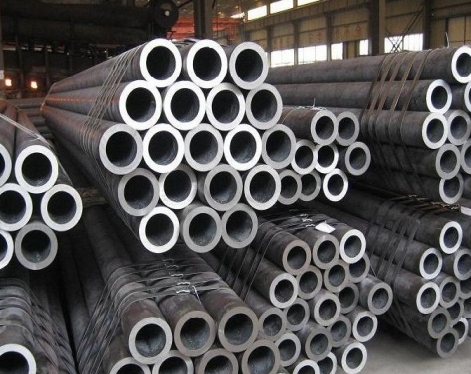In order to improve the corrosion resistance of steel pipes, general seamless pipes or welded steel pipes are galvanized. Galvanized pipes are divided into two types: hot-dip galvanizing and electric galvanizing. The hot-dip galvanizing layer is thick, the cost of electric galvanizing is low, and the surface is not very smooth.
Comparison between electro-galvanized and hot-dip galvanized
Electrogalvanizing
1. Principle
Because zinc is not easy to change in dry air, but in humid air, a very dense zinc carbonate film can be formed on the surface, which can effectively protect the interior from corrosion. And when the plating layer is damaged for some reason and the not too large substrate is exposed, the zinc and the steel pipe substrate form a micro-battery, making the steel pipe substrate a cathode and protected.
2. Performance characteristics
(1) The zinc coating is thick, the crystallization is fine, uniform and non-porous, and the corrosion resistance is good.
(2) The zinc layer obtained by electroplating is relatively pure, and it corrodes slowly in acid, alkali and other mist, which can effectively protect the gg substrate
(3) The galvanized layer is passivated by chromic acid to form white, colored, army green, etc., which are beautiful and generous, and have a certain degree of decoration
(4) Due to the good ductility of the galvanized layer, it can be formed by cold stamping, rolling, bending, etc. without damaging the coating.
3. Application scope
The fields involved in electro-galvanizing are becoming more and more extensive, and the products have been widely used in machinery manufacturing, precision instruments, chemicals, transportation, aerospace, etc., which are of great significance in the national economy.

Hot-dip galvanized
1. Principle
The hot-dip galvanized layer is formed by zinc in liquid state in three steps
(1) The iron-based surface is dissolved by the zinc solution to form a zinc-iron alloy phase layer;
(2) Zinc ions in the alloy layer further diffuse to the substrate to form a zinc-iron mutual-dissolution layer;
(3) The surface of the alloy layer is wrapped with a zinc layer.
2. Performance characteristics
A thicker and dense layer of pure zinc covers the surface of the steel pipe, which can prevent the steel pipe substrate from contacting any corrosive solution and protect the steel pipe substrate from corrosion. In the general atmosphere, a thin and dense layer of zinc oxide is formed on the surface of the zinc layer. It is difficult to dissolve in water, so it has a certain protective effect on the steel pipe matrix.
(1) If zinc oxide and other components in the atmosphere form insoluble zinc salts, the anti-corrosion effect is more ideal;
(2) It has a zinc-iron alloy alloy layer, which is densely combined, and exhibits unique corrosion resistance in marine salt spray atmosphere and industrial atmosphere; (3) Due to the firm combination, zinc-iron is soluble in each other, and has strong wear resistance;
(4) Due to the good ductility of zinc, its alloy layer adheres firmly to the steel substrate, so hot-dip galvanizing can be carried out in various forming processes such as cold stamping, rolling, wire drawing, and bending without damaging the coating;
(5) After the steel structure is hot-dip galvanized, it is equivalent to an annealing treatment, which can effectively improve the mechanical properties of the steel matrix, eliminate the stress of the steel forming and welding, and facilitate the turning of the steel structure;
(6) The surface of the fastener after hot-dip galvanizing is bright and beautiful;
(7) The pure zinc layer is the most plastic galvanized layer in hot-dip galvanizing, its properties are basically close to pure zinc, and it has good ductility.
3. Application scope
This plating method is especially suitable for steel pipes used in strong corrosive environments such as various strong acids and alkali fog.
Comparison between electro-galvanized and hot-dip galvanized
Electrogalvanizing
1. Principle
Because zinc is not easy to change in dry air, but in humid air, a very dense zinc carbonate film can be formed on the surface, which can effectively protect the interior from corrosion. And when the plating layer is damaged for some reason and the not too large substrate is exposed, the zinc and the steel pipe substrate form a micro-battery, making the steel pipe substrate a cathode and protected.
2. Performance characteristics
(1) The zinc coating is thick, the crystallization is fine, uniform and non-porous, and the corrosion resistance is good.
(2) The zinc layer obtained by electroplating is relatively pure, and it corrodes slowly in acid, alkali and other mist, which can effectively protect the gg substrate
(3) The galvanized layer is passivated by chromic acid to form white, colored, army green, etc., which are beautiful and generous, and have a certain degree of decoration
(4) Due to the good ductility of the galvanized layer, it can be formed by cold stamping, rolling, bending, etc. without damaging the coating.
3. Application scope
The fields involved in electro-galvanizing are becoming more and more extensive, and the products have been widely used in machinery manufacturing, precision instruments, chemicals, transportation, aerospace, etc., which are of great significance in the national economy.

Hot-dip galvanized
1. Principle
The hot-dip galvanized layer is formed by zinc in liquid state in three steps
(1) The iron-based surface is dissolved by the zinc solution to form a zinc-iron alloy phase layer;
(2) Zinc ions in the alloy layer further diffuse to the substrate to form a zinc-iron mutual-dissolution layer;
(3) The surface of the alloy layer is wrapped with a zinc layer.
2. Performance characteristics
A thicker and dense layer of pure zinc covers the surface of the steel pipe, which can prevent the steel pipe substrate from contacting any corrosive solution and protect the steel pipe substrate from corrosion. In the general atmosphere, a thin and dense layer of zinc oxide is formed on the surface of the zinc layer. It is difficult to dissolve in water, so it has a certain protective effect on the steel pipe matrix.
(1) If zinc oxide and other components in the atmosphere form insoluble zinc salts, the anti-corrosion effect is more ideal;
(2) It has a zinc-iron alloy alloy layer, which is densely combined, and exhibits unique corrosion resistance in marine salt spray atmosphere and industrial atmosphere; (3) Due to the firm combination, zinc-iron is soluble in each other, and has strong wear resistance;
(4) Due to the good ductility of zinc, its alloy layer adheres firmly to the steel substrate, so hot-dip galvanizing can be carried out in various forming processes such as cold stamping, rolling, wire drawing, and bending without damaging the coating;
(5) After the steel structure is hot-dip galvanized, it is equivalent to an annealing treatment, which can effectively improve the mechanical properties of the steel matrix, eliminate the stress of the steel forming and welding, and facilitate the turning of the steel structure;
(6) The surface of the fastener after hot-dip galvanizing is bright and beautiful;
(7) The pure zinc layer is the most plastic galvanized layer in hot-dip galvanizing, its properties are basically close to pure zinc, and it has good ductility.
3. Application scope
This plating method is especially suitable for steel pipes used in strong corrosive environments such as various strong acids and alkali fog.









